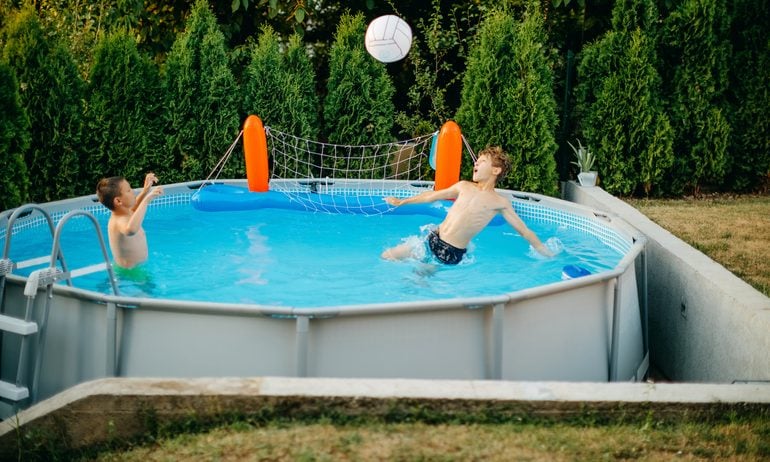How to Finance an Above-Ground Pool
Financing options for above-ground pools include credit cards, "buy now pay later,” retailer financing, personal loans and home equity options.

Many, or all, of the products featured on this page are from our advertising partners who compensate us when you take certain actions on our website or click to take an action on their website. However, this does not influence our evaluations. Our opinions are our own. Here is a list of our partners and here's how we make money.
An above-ground swimming pool can mean summertime fun in the backyard, but installing one can cost $1,000 or more. Paying with cash is an interest-free way to cover the cost of a pool, but financing options can help spread payments over time.
Can you finance an above-ground pool?
You can finance the cost of an above-ground pool in a few different ways. Credit cards, “buy now, pay later” plans and retailer financing let you borrow money and make payments until the amount is paid off.
Pool loans are another way to finance your above-ground pool. They’re personal loans used to fund a pool. They’re unsecured, so there’s no collateral, but interest rates and loan amounts can be higher than alternatives.
The final option is a home equity loan or home equity line of credit. These lending options allow you to pull from your home’s equity to fund your above-ground pool. They tend to have lower interest rates than personal loans but require your house as collateral.
If you have fair or bad credit (a score of 689 or lower), look for pool financing options with low or no minimum score requirements and check your budget to ensure you can repay the loan on time.
Ways to finance an above-ground pool
Pool loans
Pool loans are personal loans you get from a bank, credit union or online lender that you use to finance a new pool. Loan amounts range from $1,000 to $50,000, and the funds are distributed in one lump sum. These loans come with fixed annual percentage rates, so your monthly payment won’t change, and terms typically range from two to seven years.
Rates on personal loans are from 6% to 36%, and borrowers with good to excellent credit typically get the lowest rates. Many lenders can provide same-day approval and funding.
Some personal loan lenders offer home improvement loans specifically to bad credit borrowers. These lenders will consider factors beyond credit score, like your monthly cash flow and employment history, but loan rates are higher.
» MORE: Best pool loans
Pros and cons of financing for an above-ground pool with pool loans
No collateral required.
Fixed APR and monthly payments.
Fast funding.
Starting loan amounts can be high.
Rates can be high.
May charge an origination fee.
Can’t request more funds for surprise expenses or additions.
When it's best: A pool loan can be a good choice when you need a high loan amount, fast funding and you qualify for a low APR.
Home equity options
If you have at least 20% equity in your home, a home equity loan or home equity line of credit (HELOC) might be a good choice for you. Both options are akin to a second mortgage on your home. With a home equity loan, you receive a lump-sum payment and then pay it back at a fixed interest rate over an agreed period of time, typically five to 30 years.
HELOCs can be used as needed; you’ll usually have 10 years to draw from the line of credit, during which time you only have to pay interest. After that, you pay both the principal and interest.
Pros and cons of financing for an above-ground pool with equity
Lower interest rates than personal loans.
Borrowed home equity can increase your home’s value.
Home equity loans have predictable payment amounts.
May take longer to get approval and fund.
Home equity loans only cover a fixed amount.
A HELOC has a variable interest rate, so your monthly payment could change.
When it's best: A home equity loan is best for a larger renovation that will boost your home’s value, with a firm cost estimate so you know how large a loan you need. A HELOC offers more flexibility, meaning it’ll make sense if you’re not sure of the exact total, but payment amounts are less predictable.
HELOC & Home Equity Loans from our partners

on New American Funding
580
$750,000
on New American Funding

on FourLeaf Federal Credit Union
670
$1,000,000
on FourLeaf Federal Credit Union
Credit card
A credit card is a convenient way to finance an above-ground pool, but interest rates can be high on unpaid balances. One way to avoid interest is to use a card with a 0% introductory rate, which allows interest-free payments for 12 to 21 months, depending on the card. After that, the regular variable interest rate kicks in. You typically need a good or excellent credit score (690 or higher) to qualify.
Pros and cons of financing an above-ground pool with a credit card
Can be used nearly everywhere.
Allows for a fast purchase.
Can be interest-free if paid off in full each month or if you qualify for a 0% card.
Need good or excellent credit to qualify.
Interest rates are variable.
High interest rates can make the cost more expensive.
When it's best: Consider a credit card if you qualify for a 0% APR card, or you can pay off the cost of the pool before your next statement. Credit cards can be helpful if you want the flexibility to add items like ladders or heaters later on.
Pool retailer financing
Some pool retailers provide financing at lower rates than other options like credit cards. Retailers typically require an application and credit check to determine your loan eligibility.
Consider pool retailer financing if you understand approval requirements and the loan terms. Compare offers with other financing options to make sure you’re getting the lowest APR for the loan.
Pros and cons of pool retailer financing for an above-ground pool
Purchase and financing through the same company.
Low rates.
Not available with all pool retailers.
Financing may only be available on certain pool models.
May have a minimum credit score.
When it's best: A pool retailer is a good financing option when it's available for the pool you want, there are no fees and you qualify for a low rate.
Buy now, pay later
“Buy now, pay later” (BNPL) plans let you break up the cost of an above-ground pool into equal biweekly or monthly payments, sometimes at zero interest. Stores like Walmart and Home Depot offer BNPL plans from Klarna, Affirm or Afterpay online and in-store. No minimum credit score is required, but some providers run a soft credit check.
It can be easy to overspend with “buy now, pay later,” so ensure you have a plan for making all the payments. Some BNPL providers report late payments to credit bureaus, which can hurt your credit score.
Pros and cons of financing for an above-ground pool with buy now, pay later
Zero-interest plans available.
No minimum credit score required.
Available at major retailers online and in-store.
Fixed term and payments.
Some plans may charge fees.
Longer-term plans may charge interest.
Returns can be difficult.
When it's best: Buy now, pay later works best when you qualify for a zero or low-interest plan and the payments fit within your monthly budget.
» COMPARE: Best buy now, pay later apps
How much is an above-ground pool?
The cost of an above-ground pool can range from about $1,000 to $20,000, according to home services website Angi. The pool’s size, type and additional features will determine your overall cost.
Once the pool is installed, you will need to budget for ongoing costs, including cleaning, water filtration, chemical balancing and repairs. Maintenance can cost a few hundred dollars a month, depending on the size of the pool.
HELOC & Home Equity Loans from our partners

on New American Funding
580
$750,000
on New American Funding

on FourLeaf Federal Credit Union
670
$1,000,000
on FourLeaf Federal Credit Union


